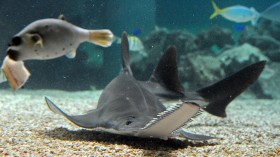Studies on greenhouse gas emissions have been pointing out agriculture as one of the contributors of a considerable amount of gas, especially from the livestock industry, but it was never easy to give them up due to the increasing demand for meat and dairy. Now, scientists have just discovered a breakthrough on how the issue can be resolved, and that's through topping some seaweeds over your livestock's regular meal.
A research led by Lames Cook University under the Australian Tropical Science and Innovation Precinct is currently testing their findings on feeding red macroalgae to farm animals with the aim of successful reducing methane emission from them. With their previous paper published last year, their significant findings have led their team to continuously observe the farm trials until mid next year to further establish evidence.
Using the Asparagopsis taxiformis with its natural antimethanogenic potential, the team tried to quantify the reduction effect of the seaweed to methane production of sheep through in-vitro fermentation. Starting from substituting 1 percent up to 5 percent of the rumen under study, methane production was significantly declining while keeping the material digestible but the efficiency of the seaweed decreased at 10 percent inclusion to the rumen inoculum. Indeed their finding may sound too technical and could only be viable on a laboratory trial but the team has also started to explore its application in real animals, making their results easier to appreciate.
"We have results already with whole sheep; we know that if Asparagopsis is fed to sheep at 2 percent of their diet, they produce between 50 and 70 percent less methane over a 72-day period continuously, so there is already a well-established precedent," co-author Rocky De Nys of the College of Marine and Environmental Sciences, also from James Cook University said.
But what's the catch in feeding 2 percent seaweed and cutting down 70 percent of methane from the livestock industry? By the numbers, the estimated global emissions from livestock account for about 3.1 gigatonnes methane. With the help of seaweeds feed with these animals, it can then cut down around 2.17 gigatonnes methane or nearly one-year carbon emission of India--just imagine that.
On the other hand, the next thing would be the availability of the red macroalgae. With Australia's CSIRO agriculture researcher Michael Battaglia's quoted statement on ScienceAlert, estimates just to cover Australia's livestock alone means around 6,000 hectares of seaweed farms.
© 2024 NatureWorldNews.com All rights reserved. Do not reproduce without permission.
![Severe Thunderstorm Alert: Tornadoes, Damaging Winds and Hail Possible from Upper Ohio Valley to Northeast US [NWS]](https://1471793142.rsc.cdn77.org/data/thumbs/full/70161/280/157/50/40/severe-thunderstorm-alert-tornadoes-damaging-winds-and-hail-possible-from-upper-ohio-valley-to-northeast-us-nws.jpg)




